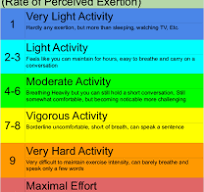Measuring Effort
Heartrate training is popular right now with so many watches making this method of tracking easier. However, monitors are not always accurate. I have ran a race that it had my heart rate go from 150 to 189 and stayed there for over 1 hour. Heartrate doesn’t change like that!
Especially with newer runners, your heartrate will be higher. If you don’t let it spike some you will never push yourself. I highly encourage athletes to also measure efforts based on pace from a 5k or using the RPE scale. The RPE scale is especially helpful on trails and/or at elevation. Your heartrate will spike at higher elevations or on a climb but that doesn’t mean you need to just walk the entire time. The best way to get better at running is to RUN!
Let’s talk more about the RPE Scale. This stands for ratings of perceived exertion. For the modified Borg Scale 0 is rest, 10 is the hardest you can go. An easy run can have a range from 1-2 with some parts (like on a climb) at a moderate 3. This is still okay for an easy run. A speed workout can range from 4 to 9. Shorter intervals allow you to meet what a 9 might be.
As a trail runner who heads to elevation and steeper terrain, your heartrate and effort can get to a 8-9 even with hiking. THAT IS OKAY! As you fatigue, a moderate effort will turn into feeling hard. Heartrate will rise, but so will RPE and you can still adjust appropriately. If you are having a good day and gaining fitness you will be able to run faster at a lower RPE. If you are too fixated on your heartrate then you will miss this opportunity to work harder and get faster!
In summary, tracking heartrate is helpful but there are other ways to also manage efforts without being too fixated on the data.

